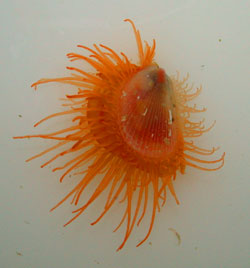NOWRAMP
2002
Creature
Feature - Fragile file shell
Fragile
file shell
Lima fragilis (Chemnitz, 1784)
 Like
scallops, these bivalves can swim! One of the researchers,
investigating an underwater boulder, caught one of these
beautiful animals as it abandoned its resting spot and took
flight. To swim they clap their two valves together, forcing
water out. Typically fileshells will swim only a short distance
before settling again to the bottom. The tentacles are sticky
and can detach, perhaps confusing predators that might take
a nip.
Like
scallops, these bivalves can swim! One of the researchers,
investigating an underwater boulder, caught one of these
beautiful animals as it abandoned its resting spot and took
flight. To swim they clap their two valves together, forcing
water out. Typically fileshells will swim only a short distance
before settling again to the bottom. The tentacles are sticky
and can detach, perhaps confusing predators that might take
a nip.
The specimen pictured was found off of Mokumanamanu (Necker
Island).
Information
from: Hawai'i's Sea Creatures, John Hoover, 1998
 Talk About It!
Talk About It!
Fragile file shell, eating, breathing and reproduction
Asked by janiece on Feb 27, 2004.
what does this animal eat how does it breathe how is it able to move does it reproduce
Answered by Andy from NOAA on May 8, 2004.
This animal is bivalve mollusc, and its family also contains scallops. It is able to breathe by extracting oxygen from the water through its gills, like fish. It is a filter feeder, like most molluscs, and filters algae out of the water. This particular animal is able to move by clapping the two parts of its shell together. It reproduces by spawning, like corals, where sperm and eggs are evected into the water column where fertilization takes place.